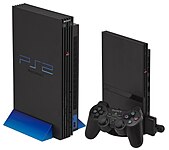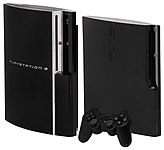PlayStation (console): Difference between revisions
Interlude65 (talk | contribs) →Specialty models: Further simplification of chart |
|||
| Line 220: | Line 220: | ||
|- |
|- |
||
! SCPH-7002 |
! SCPH-7002 |
||
| 4.1 ( |
| 4.1 (1997-12-16) |
||
| PAL |
| PAL |
||
|- |
|- |
||
Revision as of 04:06, 23 May 2013
 | |
 From top: PlayStation logo, original model with DualShock controller | |
| Manufacturer | Sony Computer Entertainment |
|---|---|
| Product family | PlayStation |
| Type | Video game console |
| Generation | Fifth generation era |
| Lifespan | PlayStation PSone |
| Discontinued | PlayStation: July 7, 2000 PSone: December 31, 2004[5] |
| Units sold | Worldwide: 102.49 million[5] |
| Media | CD-ROM (black CD) |
| CPU | MIPS R3000A-family R3051 @ 33.8688 MHz |
| Storage | Memory card |
| Input | PlayStation Controller, Dual Analog Controller DualShock |
| Best-selling game | Gran Turismo, 10.85 million shipped (as of April 30, 2008)[6][7] |
| Successor | PlayStation 2 |
The PlayStation (Japanese: プレイステーション, Hepburn: Pureisutēshon, officially abbreviated as PS; sometimes referred to as PS1 or unofficially as the PSX to maintain the three-character identifier common to the PS2, PS3 and PSP[9]) is a 32-bit video game console first released by Sony Computer Entertainment in Japan on December 3, Template:Vgy,[1] with Western releases from September 1995. The PlayStation was the first of the PlayStation series of consoles and handheld game devices.
As part of the fifth-generation of gaming, it primarily competed with the Nintendo 64 and the Sega Saturn. In 2000, a re-designed, "slim" version was released, called the PSone, replacing the original grey console, and also being renamed to avoid confusion with its successor, the PlayStation 2.
The PlayStation was the first "computer entertainment platform" to ship 100 million units, which it had reached 9 years and 6 months after its initial launch.[10] The last PSone units were sold on Christmas 2004 before it was finally discontinued, for a total of 102 million units shipped since its launch 10 years earlier. Games continued to sell until Sony ceased production of PlayStation games on March 23, 2006; over 11 years after it was released,[11] and just over half a year before the release of the PlayStation 3.
The PlayStation was the best selling console of all time from 1998 until 2006, when it was surpassed by its successor the PlayStation 2.
Development
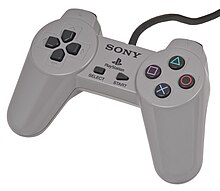
The first conceptions of the PlayStation date back to 1986. Nintendo had been attempting to work with disc-based technology since the Famicom, but the medium had problems. The Famicom Disk System's rewritable magnetic discs could be easily erased (thus leading to a lack of durability), and they lacked any sort of copy protection, thus were vulnerable to piracy. Consequently, when details of CD-ROM XA (which had neither of those problems) were released to the public, Nintendo was interested. Simultaneously developed by Sony and Philips, CD-ROM/XA was an extension of the CD-ROM format that combines compressed audio, visual, and computer data, allowing all to be accessed simultaneously. Nintendo approached Sony to develop a CD-ROM add-on, tentatively titled the "SNES-CD". A contract was signed, and work began. Nintendo's choice of Sony was due to a prior dealing: Ken Kutaragi, the person who would later be dubbed "The Father of the PlayStation", was the individual who had sold Nintendo on using the Sony SPC-700 processor for use as the eight-channel ADPCM sound set in the Super Famicom/SNES console through an impressive demonstration of the processor's capabilities.[12]
Sony also planned to develop a Super Nintendo-compatible, Sony-branded console, but one which would be more of a home entertainment system playing both Super Nintendo cartridges and a new CD format which Sony would design. This was also to be the format used in SNES-CDs, giving a large degree of control to Sony despite Nintendo's leading position in the video gaming market.
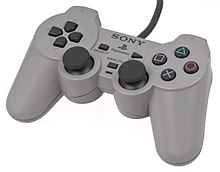
The product, dubbed the "Play Station" was to be announced at the May 1991 Consumer Electronics Show (CES). However, when Nintendo's Hiroshi Yamauchi read the original 1988 contract between Sony and Nintendo, he realized that the earlier agreement essentially handed Sony complete control over any and all titles written on the SNES CD-ROM format. Yamauchi decided that the contract was totally unacceptable and he secretly canceled all plans for the joint Nintendo-Sony SNES CD attachment. Instead of announcing a partnership between Sony and Nintendo, at 9 am the day of the CES, Nintendo chairman Howard Lincoln stepped onto the stage and revealed that Nintendo was now allied with Philips, and Nintendo was planning on abandoning all the previous work Nintendo and Sony had accomplished. Lincoln and Minoru Arakawa had, unbeknownst to Sony, flown to Philips headquarters in Europe and formed an alliance of a decidedly different nature—one that would give Nintendo total control over its licenses on Philips machines.
After the collapse of the joint project, Sony considered halting their research, but ultimately the company decided to use what they had developed so far and make it into a complete, stand-alone console. As a result, Nintendo filed a lawsuit claiming breach of contract and attempted, in U.S. federal court, to obtain an injunction against the release of what was originally christened the "Play Station", on the grounds that Nintendo owned the name. The federal judge presiding over the case denied the injunction and, in October 1991, the first incarnation of the aforementioned brand new game system was revealed. However, it is theorized that only 200 or so of these machines were ever produced.[citation needed]
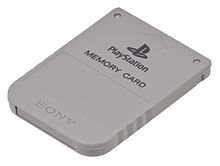
By the end of 1992, Sony and Nintendo reached a deal whereby the "Play Station" would still have a port for SNES games, but Nintendo would own the rights and receive the bulk of the profits from the games, and the SNES would continue to use the Sony-designed audio chip. However, Sony decided in early 1993 to begin reworking the "Play Station" concept to target a new generation of hardware and software. As part of this process the SNES cartridge port was dropped and the space between the names "Play Station" was removed becoming "PlayStation", thereby ending Nintendo's involvement with the project.[citation needed]
Launch
The PlayStation was launched in Japan on December 3, 1994, North America on September 9, 1995,[2] Europe on September 29, 1995,[3] and Oceania on November 15, 1995.[4] The launch price in the American market was US$299[2] and Sony enjoyed a very successful launch with titles of almost every genre, including Battle Arena Toshinden, Doom, Warhawk, Air Combat, Philosoma, and Ridge Racer. Almost all of Sony's and Namco's launch titles went on to spawn numerous sequels.
Critics praised the console for the quality of its 3-dimensional graphics. Microsoft chairman Bill Gates preferred Sony's console to the competition from Sega, saying "Our game designer likes the Sony machine."[13] Microsoft would later compete with Sony with its Xbox console. In a special Game Machine Cross Review in May 1995, Famicom Tsūshin would score the PlayStation console a 19 out of 40.[14]
Functions
In addition to playing games, the PlayStation has the ability to read and play audio CDs. The CD player has the ability to shuffle the playback order, play the songs in a programmed order, and repeat one song or the entire disk. This function, as well as a memory card manager, can be accessed by starting the console either without inserting a game or keeping the CD tray open, thereby accessing a GUI for the PlayStation BIOS. The actual GUI for both PSone and PlayStation differ graphically depending on firmware versions. If the CD lid is closed with a game inside at any time while at the menu, the game will immediately start.
Titles
As of September 30, 2007, a total of 7,918 software titles have been released worldwide (counting games released in multiple regions as separate titles).[15] As of March 31, 2007, the cumulative software shipment was at 962 million units.[16] The very last game for the system released in the United States was FIFA Football 2005. However, it can be noted that on July 26, 2007 in Japan and March 18, 2008 in the U.S., Metal Gear Solid: The Essential Collection was released, which contained new printings of the game Metal Gear Solid in the original PlayStation format. Also in 2011, Capcom released Resident Evil 15th Anniversary Collection, which contains reprinted PlayStation copies of Resident Evil, 2 and 3.[17]
Regional variants
The OK and Cancel buttons on most of the Japanese PlayStation games are reversed in their North American and European releases. In Japan, the ![]() button (maru, right) is used as the OK button, while the
button (maru, right) is used as the OK button, while the ![]() button (batsu, wrong) is used as Cancel. North American and European releases have the
button (batsu, wrong) is used as Cancel. North American and European releases have the ![]() button or the
button or the ![]() buttons as the OK button, while either the
buttons as the OK button, while either the ![]() or the
or the ![]() button is used as Cancel (some titles like Xenogears used the
button is used as Cancel (some titles like Xenogears used the ![]() button for cancelling actions and selections, along with the PlayStation 2 system browser and the XrossMedia Bar on the PlayStation 3 and the PSP). However, a few games, such as Square's Vagrant Story, Final Fantasy VII (which used the
button for cancelling actions and selections, along with the PlayStation 2 system browser and the XrossMedia Bar on the PlayStation 3 and the PSP). However, a few games, such as Square's Vagrant Story, Final Fantasy VII (which used the ![]() button as cancel) and Final Fantasy Tactics, Namco's Ridge Racer Type 4, and Konami's Metal Gear Solid, use the Japanese button layout worldwide. Some other games, like the Japanese version of Gran Turismo, had used different controls that are similar to North American games. These Japanese button layouts still apply to other PlayStation consoles. This is because in the early years Sony America (SCEA), Sony Europe (SCEE), and Sony Japan (SCEJ) had different development and testing documents (TRCs) for their respective territories.
button as cancel) and Final Fantasy Tactics, Namco's Ridge Racer Type 4, and Konami's Metal Gear Solid, use the Japanese button layout worldwide. Some other games, like the Japanese version of Gran Turismo, had used different controls that are similar to North American games. These Japanese button layouts still apply to other PlayStation consoles. This is because in the early years Sony America (SCEA), Sony Europe (SCEE), and Sony Japan (SCEJ) had different development and testing documents (TRCs) for their respective territories.
Variants

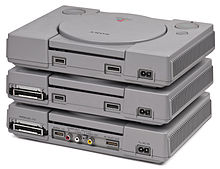
The PlayStation went through a number of variants during its production run, each accompanied by a change in the part number. From an external perspective, the most notable change was the gradual reduction in the number of external connectors on the unit. This started very early on—the original Japanese launch units (SCPH-1000) had an S-Video port, which was removed on the next release. This also led to the strange situation where the US and European launch units had the same part number series (SCPH-100x) as the Japanese launch units, but had different hardware (Rev. C silicon and no S-Video port)—they were the same as the Japanese SCPH-3000, so for consistency should have been SCPH-3001 and SCPH-3002 (this numbering was used for the Yaroze machines, which were based on the same hardware and numbered DTL-H3000, DTL-H3001, and DTL-H3002). Also, the first models (DTL-H1000, DTL-H1001, DTL-H1002) had some problems with printf function and developers had to use another function instead. This series of machines had a reputation for CD drive problems—the optical pickup sled was made of thermoplastic, and eventually developed wear spots that moved the laser into a position where it was no longer parallel with the CD surface—a modification was made that replaced the sled with a die-cast one with hard nylon inserts, which corrected the problem.
SCPH-100x models are notable for being sought after and modded by audiophile enthusiasts, because most consoles from this line featured a DAC by Ashahi Kasei Microsystems (AKM) and had RCA output.[18]
With the release of the SCPH-500x series being produced only in Japan, it followed the same exterior design as the Japanese SCPH-300x series, its only differences being that it upgraded some flawed components from previous models and a reduced retail value. This series also contained the SCPH-550x and exclusive PAL SCPH-555x units. A number of changes were made to the SCPH-550x series internally (CD drive relocated, shielding simplified, PSU wiring simplified) and the RCA jacks and RFU power connectors were removed from the rear panel and the printed text on the back was changed to reliefs of the same. Starting with the SCPH-555x series, PAL variants had the "power" and "open" buttons changed from text to symbols.[19]
These were followed by the SCPH-700x and SCPH-750x series—they are externally identical to the SCPH-500x machines, but have internal changes made to reduce manufacturing costs (for example, the system RAM went from 4 chips to 1, and the CD controller went from 3 chips to 1). A slight change of the startup screen was made. The diamond is seen as longer and thinner and the trademark symbol (™) is now placed after "Computer Entertainment" instead of after the diamond, as it was on the earlier models. Also new to the SCPH-7xxx series was the introduction of the "Sound Scope" - light show music visualizations. These were accessible by pressing the Select button while playing any normal audio CD in the system's CD player. While watching these visualizations, players could also add various effects like color cycling or motion blur. These music visualizations were kept in all future PlayStation 1 models.
The final revision to the original PlayStation was the SCPH-900x series—these had the same hardware as the SCPH-750x machines with the exception of the removal of the parallel port and a slight reduction in the size of the PCB. The removal of the parallel port was probably partly because no official add-on had ever been released for it, and partly because it was being used to connect cheat cartridges that could be used to defeat the regional lockouts and copy protection.
The PSone was based on essentially the same hardware as the SCPH-900x, but had the serial port removed, the controller / memory card ports moved to the main PCB and the power supply replaced with an AC/DC converter that was also on the main PCB. Also the overall system menu received a graphical overhaul, along with a surround sound/echo effect being added to the CD player menu.
Earliest series had potentiometers on the board for adjusting the reading mechanism, named BIAS, GAIN and an unknown one. By connecting a voltmeter between the upper-most metering point near the BIAS potentiometer and the chassis, the resulting voltage could be read. The supposed right values are 1.70 V when a CD is spinning at 1x speed and 1.85 V when a CD is spinning at 2x speed. Further tuning was also possible on the unique potentiometer present on the CD drive. Later series featured an automatic laser calibration mechanism.
Another version that was colored blue (as opposed to regular console units that were grey in color) was available to game developers and select press. Later versions of this were colored green—on a technical level, these units were almost identical to the retail units, but had a different CD controller in them that did not require the region code found on all pressed disks, since they were intended to be used with CD-R media for debugging. This also allowed the use of discs from different regions, but this was not officially supported; different debug stations existed for each region. The two different color cases were not cosmetic—the original blue debug station (DTL-H100x, DTL-H110x) contained "Revision B" silicon, the same as the early retail units (these units had silicon errata that needed software workarounds), the green units (DTL-H120x) had Rev. C hardware. As part of the required tests, the user had to test the title on both. Contrary to popular belief, the RAM was the same as the retail units at 2 MB. The firmware was nearly identical—the only significant change was that debug prints got sent to the serial port if the title did not open it for communications—this used a DTL-H3050 serial cable (the same as the one used for the Yaroze).
Hardware problems
With the early units, many gamers experienced skipping full-motion video or physical "ticking" noises coming from their PlayStations. The problem appears to have come from poorly placed vents leading to overheating in some environments—the plastic moldings inside the console would warp very slightly and create knock-on effects with the laser assembly. The solution was to ensure the console was sat on a surface which dissipated heat efficiently in a well vented area, or raise the unit up slightly by propping something at its edges. A common fix for already affected consoles was to turn the PlayStation sideways or upside-down (thereby using gravity to cancel the effects of the warped interior).[citation needed]
Copy protection
Prior to the PlayStation, the reproduction of copyrighted material for gaming consoles was restricted to either enthusiasts with exceptional technical ability, or others that had access to CD manufacturers. However, the increased availability of cheap CD burners at this time led Sony to introduce several methods to make PlayStation discs difficult to copy:
- Sectors 12 through 15 contain an invalid zeroised EDC/ECC checksum, so if the PS reads and does not see an invalid EDC/ECC then it knows that the CD in the drive is a copy. The error is pressed into the disc at the time of manufacture, and cannot be reproduced on most CD-R recorders because the recorder will automatically regenerate the 'corrupt' sector's checksum.
- The PlayStation uses a mixed-mode format with most data in Mode 2/Form 1 and streaming audio/video data in Mode 2/Form 2. Most CD-R drives at the time could not handle this variation well, but newer drives are able to.
- Discs were manufactured with a black-colored plastic (transparent only to the infrared radiation used by CD-ROM lasers), and it was theorized[citation needed] that the PlayStation's drive was engineered to require these tinted discs. However, this is easily disproven, as PlayStation CD-ROMs can be read by most CD drives, and the PlayStation will read standard audio CDs and most recordable CDs.[citation needed] There are reports of dark blue-colored plastic CDs used at the end of the console's lifetime too, specially in PAL territories.[citation needed] Tinted discs were also used in early CD based games for the PlayStation 2.
The installation of a modchip allowed the PlayStation to play games recorded on a regular CD-R. It also allowed the console's capabilities to be expanded in other ways, such as playing games from other regions. By the end of the system's life cycle almost anyone with minimal soldering experience was able to perform these modifications. This created a wave of games developed without official approval using free, unofficial tools, as well as the reproduction of original discs. With the introduction of such devices the console became very attractive to programmers and illegal copiers alike, as well as those who merely wished to protect the lifespan of their lawful, original discs.[citation needed]
Some companies (notably Datel) did manage to produce discs that booted on unmodified retail units, but this required special equipment and could only be done with "pressed" discs.[citation needed]
Net Yaroze
A version of the PlayStation called the Net Yaroze was also produced. It was more expensive than the original PlayStation, colored black instead of the usual gray, and most importantly, came with tools and instructions that allowed a user to be able to program PlayStation games and applications without the need for a full developer suite, which cost many times the amount of a PlayStation and was only available to approved video game developers. Naturally, the Net Yaroze lacked many of the features the full developer suite provided.[citation needed] Programmers were also limited by the 2 MB of total game space that Net Yaroze allowed.[20] The amount of space may seem small, but games like Ridge Racer ran entirely from the system RAM (except for the streamed music tracks). It was unique in that it was the only officially retailed PlayStation with no regional lockout; it would play games from any territory. It would not however play CD-R discs, so it was not possible to create self-booting Yaroze games without a modified PlayStation.
PSone
 | |
 | |
| Manufacturer | Sony Computer Entertainment |
|---|---|
| Product family | PlayStation |
| Type | Video game console |
| Generation | Fifth generation era |
| Lifespan | July 7, 2000[1] – December 31, 2004[5] |
| Units sold | 28.15 million[5] |
| Controller input | DualShock |
The PSone is Sony's smaller, redesigned version of its PlayStation video game console.[21] The PSone is considerably smaller than the original PlayS (dimensions being 38 mm × 193 mm × 144 mm versus 45 mm × 260 mm × 185 mm). It was released on July 7, 2000,[22] and went on to outsell all other consoles throughout the remainder of the year—including Sony's own PlayStation 2 (yet the Playstation 2 overtook this eventually).[21] The PSone is fully compatible with all PlayStation software.
There were six differences between the PSone and the original PlayStation. The first was a major cosmetic change to the console; it became much smaller. The second was the lack of a separate reset button; the user "resets" this console simply by turning it off and then on again (the power button also has the word "RESET" on it to reduce confusion by users reading a game manual referencing a reset button that is effectively nonexistent). The third was the system menu Graphical User Interface. The fourth was an added protection against the use of modchips (by changing the internal layout and making previous-generation modchip devices unusable). The fifth is a lack of the original PlayStation's parallel and serial ports. These ports allowed multiple consoles to be connected for multiplayer, or to connect a console to debugging software, as well as to third-party game enhancement devices such as the GameShark. The sixth is that when the console is started up, instead of a trademark symbol (™) beside the words "Computer Entertainment" there is a registered trademark symbol (®).

Sony also released a version with a 5" LCD screen and an adaptor (though it did not have a battery: it is powered by plugging the adapter in a mains socket, or in a car). It was called the Combo pack.
Summary of PlayStation models
The last digit of the PlayStation model number denotes the region in which it was sold:
- 0 is Japan (Japanese boot ROM, NTSC:J region, NTSC Video, 100 V PSU)
- 1 is USA/Canada (English boot ROM, NTSC:U/C region, NTSC Video, 110 V PSU)
- 2 is Europe/Australia/PAL region (English boot ROM, PAL region, PAL Video, 220 V PSU)
- 3 is Asia (Japanese boot ROM, NTSC:J region, NTSC video, 220 V PSU)
Consumer models
| Model: | Case: | BIOS: | Hardware: | Region: | A/V Direct Out: | Parallel Port: | Serial Port: | Notes: |
|---|---|---|---|---|---|---|---|---|
| SCPH-1000 | Original (Grey) | Unknown (1994-09-22) | Rev. A | NTSC-J | Yes | Yes | FMV skipping issues. S-Video direct out. | |
| SCPH-1001 | 2.2 (1995-12-04) | Rev. B | NTSC-U/C | FMV skipping issues. Based on the SCPH-3000 series. | ||||
| SCPH-1002 | 2.0 (1995-05-10) | PAL | ||||||
| 2.1 (1995-07-17) | ||||||||
| 2.2 (1995-12-04) | ||||||||
| SCPH-3000 | 1.1 (1995-01-22) | NTSC-J | FMV skipping issues. Earliest units had a PU-7 board, further units featured a PU-8 board like the SCPH-1002. SCPH-3500: 2 controllers were included. | |||||
| SCPH-3500 | 2.1 (1995-07-17) | |||||||
| SCPH-5000 | 2.2 (1995-12-04) | Rev. C | FMV skipping issues. | |||||
| SCPH-5001 | Unknown (Unknown) | NTSC-U/C | No | CD-ROM drive re-located on right side of CD bay. Lens carriage reinforced and power simplified, fixing FMV skipping issues. A/V direct out and RFU power connector removed. Model numbers synchronized worldwide. Lens assembly attuned specifically to the black disks to circumvent piracy.[citation needed] SCPH-5552: A very rare Men in Black promotional model exists with a black case and the film's logo on the CD lid. SCPH-5903: Only model capable of playing Video CD movies. This model also has RCA plugs, like earlier PlayStation models. | ||||
| SCPH-5002 | PAL | |||||||
| SCPH-5003 | NTSC-J | |||||||
| SCPH-5500 | 3.0 (1996-09-09) | |||||||
| SCPH-5501 | 3.0 (1996-11-18) | NTSC-U/C | ||||||
| SCPH-5502 | 3.0 (1997-01-06) | PAL | ||||||
| SCPH-5503 | Unknown (Unknown) | NTSC-J | ||||||
| SCPH-5552 | 3.0 (1997-01-06) | PAL | ||||||
| SCPH-5903 | Original (White) | Unknown (Unknown) | NTSC-J | Yes | ||||
| SCPH-7000 | Original (Grey) | 4.0 (1997-08-18) | No | DualShock now standard. Introduction of Sound Scope. Major manufacturing cost reductions took place from this model onwards. The number of memory chips and CD-ROM controllers were reduced, other components were simplified. SCPH-7000, SCPH-7001, and SCPH-7002: Available in midnight blue as promotional item to celebrate the 10 millionth PlayStation sold. | ||||
| SCPH-7001 | 4.1 (1997-12-16) | NTSC-U/C | ||||||
| SCPH-7002 | 4.1 (1997-12-16) | PAL | ||||||
| SCPH-7003 | 3.0 (1996-11-18) | NTSC-J | ||||||
| SCPH-7500 | Unknown (Unknown) | |||||||
| SCPH-7501 | 4.1 (1997-12-16) | NTSC-U/C | ||||||
| SCPH-7502 | PAL | |||||||
| SCPH-7503 | NTSC-J | |||||||
| SCPH-9000 | 4.0 (1997-08-18) | No | Yes | Parallel port removed (hidden under case on earlier 9000 units, completely removed on later 9000 models.). Motherboard PCB reduced in size. Higher quality CD-Rom than previous models. | ||||
| SCPH-9001 | 4.1 (1997-12-16) | NTSC-U/C | ||||||
| SCPH-9002 | PAL | |||||||
| SCPH-9003 | Unknown (Unknown) | NTSC-J | ||||||
| SCPH-100 | PSone (White) | 4.3 (2000-03-11) | No | Redesigned smaller case. Controller and memory card ports integrated onto motherboard. Serial port removed. Has external power supply. | ||||
| SCPH-101 | 4.5 (2000-05-25) | NTSC-U/C | ||||||
| SCPH-102 | 4.4 (2000-03-24) | PAL | ||||||
| 4.5 (2000-05-25) | ||||||||
| SCPH-103 | Unknown (Unknown) | NTSC-J | ||||||
Specialty models
| Model: | Case: | BIOS: | Hardware: | Region: | CD-R copies: | Notes*: | |
|---|---|---|---|---|---|---|---|
| DTL-H1000 | Original (Blue) | Unknown (22/09/94) | Rev. A | NTSC-J | Yes | S-Video direct out. | Debugger. |
| DTL-H1000H | Original (Grey) | 1.1 (22/01/95) | Rev. B | ||||
| DTL-H1001 | Original (Blue) | 2.0 (07/05/95) | NTSC-U/C | ||||
| DTL-H1001H | Original (Grey) | Unknown (Unknown) | |||||
| DTL-H1002 | Original (Blue) | 2.0 (10/05/95) | PAL | ||||
| DTL-H1100 | 2.2 (06/03/96) | NTSC-J | Has external power supply. | ||||
| DTL-H1101 | 2.1 (17/07/95) | NTSC-U/C | |||||
| DTL-H1102 | PAL | ||||||
| DTL-H1200 | Original (Green) | 2.2 (04/12/95) | Rev. C | NTSC-J | |||
| DTL-H1201 | NTSC-U/C | ||||||
| DTL-H1202 | PAL | ||||||
| DTL-H3000 | Original (Black) | Unknown (Unknown) | Rev. B | NTSC-J | No | Net Yaroze hobbyist development system. | |
| DTL-H3001 | 2.2 (04/12/95) | NTSC-U/C | |||||
| DTL-H3002 | PAL | ||||||
*All models feature A/V Direct Out, Parallel Port and Serial Port; none feature Sound Scope
*All models use a low-quality CD drive.
*All models can boot software with any region code.
Successors
Sony's successor to the PlayStation is the PlayStation 2, which is backwards compatible with its predecessor in that it can play almost every PlayStation game. The third generation of the PlayStation, the PlayStation 3, was launched on November 11, 2006 in Japan, November 17, 2006 in North America, and March 23, 2007 in Europe. Like the PlayStation 2, the PlayStation 3 is able to play most original PlayStation games (with some early models also able to play PlayStation 2 games). While PlayStation 3 games are not region-locked, PlayStation and PlayStation 2 games are only playable on PlayStation 3 consoles from the same region. A third successor, the PlayStation 4, was announced by Sony on February 20, 2013 and is set to be released in Q4 2013.
The PlayStation Portable, or PSP, is a handheld game console first released in late 2004. The PSP is capable of playing PlayStation games downloaded via Sony's online store, and can also play any PlayStation game by using the PlayStation 3's remote play feature while the disc is in the PlayStation 3. Sony hopes to release nearly all PlayStation games on a gradual basis.[23] It is also possible to convert original PlayStation disc images into executable binaries using freely available software. These games are then playable on PSPs that have been modified to run unsigned code.
The successor to the PSP, the PlayStation Vita, was introduced as a part of the 8th generation of video game consoles.
-
Original and slimline PlayStation 2
-
Original (60 GB) and slim PlayStation 3
-
An original (1000 series) PlayStation Portable
Legacy
Sony Computer Entertainment was an upstart in the video game industry in 1994, as the early 1990s were dominated by Nintendo with Sega in second place. Nintendo had dominated the video game industry since the introduction of the NES in 1985 and the Nintendo 64 was initially expected to continue Nintendo's dominance in the video game industry. Sony focused on a broader base of audiences including adults, and marketed the PlayStation for newcomers and an older age group but ignored the younger audience below 15 who are staunch in their loyalty to Nintendo and Sega.[24] By the late 1990s, Sony became the undisputed number one video game manufacturer due to the PlayStation, with a significant lead over second-place Nintendo while Sega was relegated to a distant third.
The PlayStation's lead in installed base and developer support paved the way for the success of the next-generation PlayStation 2, which overcame an early launch from the Sega Dreamcast and then fended off competition from the Microsoft Xbox and Nintendo GameCube.[25][26][27]
CD format
The success of the PlayStation is widely believed to have influenced the demise of the cartridge-based home console. While not the first system to utilize an optical disc format, it was the first success story, and ended up going head-to-head with the last major home console to rely on proprietary cartridges—the Nintendo 64.[26]
Nintendo was very public about its skepticism toward using CDs and DVDs to store games, citing longer load times and durability issues.[28] It was widely speculated that the company was even more concerned with copyright infringement, given its substantial reliance on licensing and exclusive titles for its revenue. [citation needed] Piracy was rampant on the PlayStation due to the relative ease of the installation of a modchip, allowing the PlayStation to play games region free and/or recorded on a regular CD-R, making the console very attractive to programmers and illegal copiers alike.
The increasing complexity of games (in content, graphics, and sound) pushed cartridges to their storage limits and this gradually turned off third-party developers. Also, CDs were appealing to publishers due to the fact that they could be produced at a significantly lower cost and offered more production flexibility to meet demand. As a result, most third-party developers switched to the PlayStation, such as Square and Enix, whose Final Fantasy VII and Dragon Quest VII were initially pre-planned for the N64,[29] while some who remained released fewer games to the Nintendo 64 (Konami, releasing only thirteen N64 games but over fifty on the PlayStation). While new games were coming out rapidly for the PlayStation, new Nintendo 64 game releases were infrequent and that system's biggest successes were developed by either Nintendo itself or by second-parties of Nintendo, such as Rare.
Quality of construction
The first batch of PlayStations used a KSM-440AAM laser unit whose case and all movable parts were completely made out of plastic. Over time, friction caused the plastic tray to wear out—usually unevenly. The placement of the laser unit close to the power supply accelerated wear because of the additional heat, which made the plastic even more vulnerable to friction. Eventually, the tray would become so worn that the laser no longer pointed directly at the CD and games would no longer load. Sony eventually fixed the problem by making the tray out of die-cast metal and placing the laser unit farther away from the power supply on later models of the PlayStation.
Some units, particularly the early 100x models, would be unable to play FMV or music correctly, resulting in skipping or freezing. In more extreme cases the PlayStation would only work correctly when turned onto its side or upside down.
Homebrew Scene
Making games on the PlayStation is possible with any model of the system through the use of a modchip or the double 'Swap Trick'. Requirements consist of a PC (Personal Computer), SDK (Software Development Kit), and a 'Comms Link' device to upload and download files to and from the console.
Homebrew was originally promoted by Sony with the Net Yaroze, which had a large scene for quite some time. However, the official Net Yaroze site was shut down in mid-2009, and Sony stopped supporting the system as well as the users who still owned the console. As of 2012, the website PSXDEV (not affiliated with Sony) is a replacement to help bring the homebrew scene back for the PlayStation 1 and Net Yaroze.
Technical specifications
This section needs additional citations for verification. (December 2010) |
Central processing unit
|
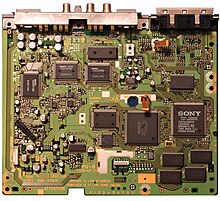  Graphics processing unit
Sound processing unit
Other
Connectivity
|
See also
- Libcrypt
- List of PlayStation games
- PlayStation Demo Discs
- PlayStation palmar hidradenitis
- PlayStation Sound Format
- Runix
References
- ^ a b c "Business Development/Japan". Sony Computer Entertainment Inc. Retrieved 2007-12-19.
- ^ a b c "Business Development/North America". Sony Computer Entertainment Inc. Retrieved 2000-24-11.
{{cite web}}: Check date values in:|accessdate=(help) - ^ a b "Business Development/Europe". Sony Computer Entertainment. Retrieved 2007-12-19.
- ^ a b "SCEE 1995—Key Facts and Figures". Sony Computer Entertainment. Retrieved 2000-11-25.
{{cite web}}: Check date values in:|accessdate=(help) - ^ a b c d "PlayStation Cumulative Production Shipments of Hardware". Sony Computer Entertainment. Retrieved 2012-05-12. Cite error: The named reference "shipments" was defined multiple times with different content (see the help page).
- ^ "Gran Turismo Series Shipment Exceeds 50 Million Units Worldwide" (Press release). Sony Computer Entertainment. 2008-05-09. Retrieved 2008-06-03.
- ^ "'Gran Turismo' Series Software Title List". Polyphony Digital. 2010. Retrieved 2010-10-24.
{{cite web}}: Unknown parameter|month=ignored (help) - ^ "The Making Of: PlayStation". Edge. Future Publishing. 24 April 2009. p. 5. Retrieved 27 September 2009.
SCEA hated the name and wanted to change it to PSX, a contraction of the project's codename […] the US nevertheless went ahead with early trade promotion, calling it PSX,
- ^ PS-X (PlayStation Experimental) was an internal code name for the PlayStation during development.[8] The popular use of the "PSX" abbreviation outside Sony became a source of confusion when Sony Of Japan ignored Sony of America's decision and introduced its PSX digital video recorder in 2003.
- ^ "PlayStation 2 Breaks Record as the Fastest Computer Entertainment Platform to Reach Cumulative Shipment of 100 Million Units" (PDF) (Press release). Sony Computer Entertainment. 2005-11-30. Retrieved 2008-06-08.
- ^ Sinclair, Brendan (2006-03-24). "Sony stops making original PS". GameSpot. Retrieved 2009-08-20.
- ^ "Game Over", by David Scheff
- ^ Brandt, Richard L. "Nintendo Battles for its Life." Upside 7.10 (1995): 50-. ABI/INFORM Global. Web. 24 May 2012.
- ^ GAME MACHINE CROSS REVIEW: プレイステーション. Weekly Famicom Tsūshin. No.335. Pg.166. 12–19 May 1995.
- ^ "Cumulative Software Titles". Sony Computer Entertainment Inc. Retrieved 2007-12-10.
- ^ "Cumulative Production Shipments of Software Titles". Sony Computer Entertainment. 2007-03-31. Retrieved 2007-07-10.
- ^ Search: (2008-03-18). "Gamefaqs Product page". Gamefaqs.com. Retrieved 2010-11-11.
{{cite web}}: CS1 maint: extra punctuation (link) - ^ "The Original PlayStation: An Audiophile's Dream? - Musical Musings". Musicalmusings.themindofgame.com. 2010-06-21. Retrieved 2012-10-27.
- ^ "SCPH". maru-chang.com. 2005-10-26. Retrieved 2013-01-02.
- ^ "PlayStation Turns 10". Electronic Gaming Monthly (197): 174. 2005.
{{cite journal}}: Unknown parameter|month=ignored (help) - ^ a b Smith, Tony (2000-12-06). "Sony PS One sales rocket as PS Two famine continues". theregister.co.uk. Retrieved 2008-08-22.
- ^ "SCEE 2000—Key Facts and Figures". Sony Computer Entertainment Europe. Retrieved 2006-11-25.
- ^ Gantayat, Anoop (2006-03-15). "Sony Outlines PSP Future". IGN. Retrieved 2007-07-10.
- ^ GOODFELLOW, KRIS (May 25, 1998). "Sony Comes On Strong in Video-Game War". New York Times.
- ^ "PlayStation is number 7". IGN. Retrieved 2012-10-27.
- ^ a b By McKinley Noble, GamePro (2009-08-31). "5 Biggest Game Console Battles". PCWorld. Retrieved 2012-10-27.
- ^ "Sega vs. Sony: Pow! Biff! Whack!". Businessweek.com. 2000-12-18. Retrieved 2012-10-27.
- ^ Nintendo Power August, 1994 - Pak Watch. Nintendo. 1994. p. 108.
- ^ "Elusions: Final Fantasy 64". Retrieved 2009-01-11.
- ^ http://www.8-bitcentral.com/images/sony/playstation/boxBack.jpg[verification needed]

